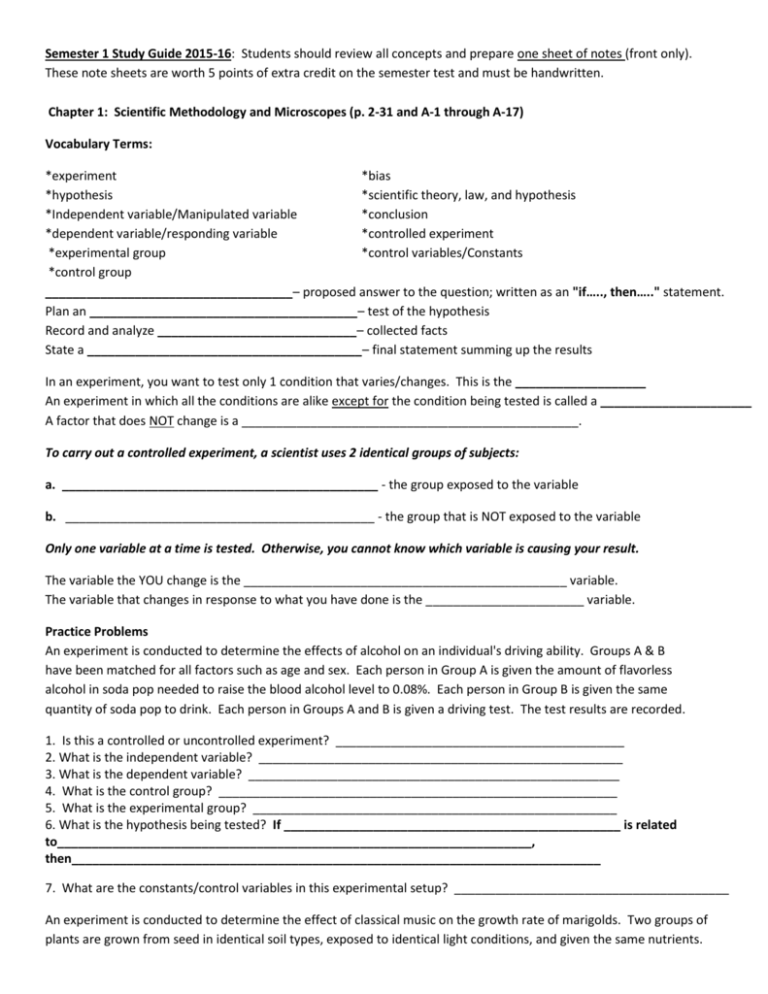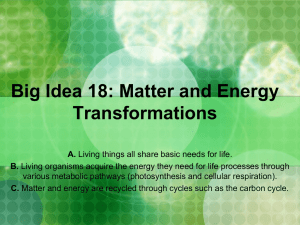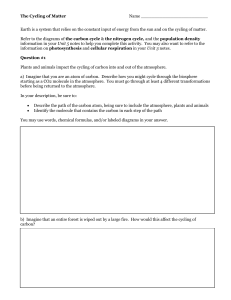semester test review
advertisement

Semester 1 Study Guide 2015-16: Students should review all concepts and prepare one sheet of notes (front only). These note sheets are worth 5 points of extra credit on the semester test and must be handwritten. Chapter 1: Scientific Methodology and Microscopes (p. 2-31 and A-1 through A-17) Vocabulary Terms: *experiment *bias *hypothesis *scientific theory, law, and hypothesis *Independent variable/Manipulated variable *conclusion *dependent variable/responding variable *controlled experiment *experimental group *control variables/Constants *control group ____________________________________– proposed answer to the question; written as an "if….., then….." statement. Plan an _______________________________________– test of the hypothesis Record and analyze _____________________________– collected facts State a ________________________________________– final statement summing up the results In an experiment, you want to test only 1 condition that varies/changes. This is the ___________________ An experiment in which all the conditions are alike except for the condition being tested is called a ______________________ A factor that does NOT change is a _________________________________________________. To carry out a controlled experiment, a scientist uses 2 identical groups of subjects: a. ______________________________________________ - the group exposed to the variable b. _____________________________________________ - the group that is NOT exposed to the variable Only one variable at a time is tested. Otherwise, you cannot know which variable is causing your result. The variable the YOU change is the _______________________________________________ variable. The variable that changes in response to what you have done is the _______________________ variable. Practice Problems An experiment is conducted to determine the effects of alcohol on an individual's driving ability. Groups A & B have been matched for all factors such as age and sex. Each person in Group A is given the amount of flavorless alcohol in soda pop needed to raise the blood alcohol level to 0.08%. Each person in Group B is given the same quantity of soda pop to drink. Each person in Groups A and B is given a driving test. The test results are recorded. 1. Is this a controlled or uncontrolled experiment? __________________________________________ 2. What is the independent variable? _____________________________________________________ 3. What is the dependent variable? ______________________________________________________ 4. What is the control group? __________________________________________________________ 5. What is the experimental group? _____________________________________________________ 6. What is the hypothesis being tested? If _________________________________________________ is related to_____________________________________________________________________, then_____________________________________________________________________________ 7. What are the constants/control variables in this experimental setup? ________________________________________ An experiment is conducted to determine the effect of classical music on the growth rate of marigolds. Two groups of plants are grown from seed in identical soil types, exposed to identical light conditions, and given the same nutrients. Group A is in a quiet atmosphere. The plants in Group B are provided with the same atmosphere except that classical music is played for 12 hours daily. The scientist measures the plants in both groups each day and records the results. 1. Is this a controlled or uncontrolled experiment? __________________________________________ 2. What is the independent variable? _____________________________________________________ 3. What is the dependent variable? ______________________________________________________ 4. What is the control group? __________________________________________________________ 5. What is the experimental group? _____________________________________________________ 6. What is the hypothesis being tested? If _________________________________________________ is related to_____________________________________________________________________, then_____________________________________________________________________________ 7. What are the constants/control variables in this experimental setup? ________________________________________ Microscopes and Metric Measurement Chapter 2: Chemistry (p.32-59 and A-24) Vocabulary Terms: *atom *proton *electron *neutron *isotope *atomic number *atomic mass *bohr model *lewis dot structure *covalent bonding *ionic bonding *Valence electrons *carbohyrdates and monomers of carbs *proteins and monomers of proteins *lipids and monomers of lipids *nucleic acids and monomers of lipids *elements in each of the macromolecules Atoms: Know the structure of the atom and the locations and charge of each of the subatomic particlesRules for electrons in shells/energy levels First level Second energy level Third energy level A pure substance made of one type of atom is called a . If an atom has an atomic number of 10, It has 10 protons. How many electrons does it have? Carbon 12, Carbon-13, and carbon-14 all have the same number of in the nucleus but different numbers of . They are called . Define Compound*remember number of protons = number of electrons. Neutrons can be the same as protons, but can also vary in neutrons – this is an isotope Shell rules- 2 electrons in first shell/energy level, 8 in second, Bohr models- drawing showing all electrons in each shell EXAMPLE: Draw your own Bohr model of - Aluminum – look up atomic number Lewis Dot structure- shows only valence electrons Valence electronsWhy are valence electrons important Draw a Lewis Dot Structure of Aluminum Bonding of elements CovalentIonic- transfer of electrons- forms ions –Example Bohr model of Sodium (Na) Lewis Dot Structure of Sodium- outer shell has only 1 electron CovalentCovalent is between a nonmetal and a Drawing of 2 Hydrogen + Oxygen (also show polarity) Draw 1 carbon and 4 hydrogen Type of bond- Type of bond ionic – Ionic bonds are between metal and Hydrogen bondsShow bonding of one sodium (Na) and 1 Chlorine (Cl) *use lewis dot structures . Show bonding between 1 aluminum and 3 chlorine Polarity of water Polarity- review drawing of oxygen- where are the covalent bonds and where are the hydrogen bonds Properties because of polarityCohesionAdhesionheat capacitySolventWhat type of molecules can water dissolve? Why? Solutions SolventSoluteWhy is water such a fantastic solvent? In a solution, if water is the solvent, sodium chloride, or salt is the . pH Define-: _______________________________________________________________________________________ Draw a pH scale- label where H+ ions increase and OH- increase- label acids, bases, and neutral What is the pH of water? What is the pH of many of your biological systems in your body? A solution that produces H+ (hydrogen ions) in a solution is an A solution that produces 0H- (hydroxide ions) in a solution is a Your stomach has a lot of HCL which dissociates into H+ and Cl-, increasing the H+ ions. This increases/decrease pH and becomes more/less acidic. Would the pH be closer to 3 or 10? What is a buffer? Define; know importance, and basic requirements for buffers to work. List 4Fill in the table below Carbohydrates Elements and ratios of each Foods where molecules are found How are they used in our body Monomer s that make up compound Proteins Lipids Nucleic Acids Define monomer Define polymer EnzymesWhat type of organic molecule is an enzyme Define enzymeDefine active siteList monosaccharidesList disaccharidesQuick energy = what macromolecule Structural function= Insulation and stored energy Heredity Human digestion*know structure and function of each of the structures on the diagram *Digestion of carbohydrates occurs in Enzymes *Digestion of proteins occurs in Enzymes *Digestion of lipids occurs in Enzymes Ecology– Chapters 3-5 (p.61-151) Chapter 3: The Biosphere Vocabulary Terms: *Ecology *species *populations *community *ecosystem *biome *biosphere *heterotroph *autotroph *photosynthetic *chemosynthetic *energy pyramid and 10% rule *biotic *abiotic *primary producers *Consumers *herbivore *carnivore *scavenger *omnivore *detritivore *decomposer *biological components of carbon, nitrogen, phosphorus cycles What is the level of organization of the biosphere (entire planet) Put in order populations, community, species, biome, ecosystem, individual organisms *Carbon enters biological systems through photosynthesis or chemosynthesis. Photosynthetic producers (plants, algae, blue-green bacteria) intake CO2 from the atmosphere and incorporate it into their structure as starch. The equation for photosynthesis is CO2 + H20 – C6H12O6 (glucose) and O2 (oxygen). Now there is carbon in the form of glucose/starch in producers. Carbon in the form of glucose enters the food chain through consumers (herbivores or omnivores). This gets passed through the food chain and is used for all macromolecules – lipids, carbohydrates, proteins, and nucleic acids. *Deforestation and burning of fossil fuels (lights in home, car driving, plane flying, etc) cause an increase in carbon dioxide in the atmosphere which blocks energy from leaving the atmosphere and increases global temperature PRACTICE Energy in Ecosystems—REMEMBER the arrows point from the item being eaten to the eater. What organism(s) above is/ are producers? What organisms are consumers? What organisms are primary consumers? Secondary consumers? Tertiary Consumers? What organisms are heterotrophs? Autotrophs? What organisms are decomposers? Which organisms are omnivores? Herbivores? Carnivores? If 100% energy is available from producers, how much will be available for second level consumers? Third level? What happens to the energy that is not used for the next trophic level (given off as what)? *Carbon enters biological systems through photosynthesis or chemosynthesis. Photosynthetic producers (plants, algae, blue-green bacteria) intake CO2 from the atmosphere and incorporate it into their structure as starch. The equation for photosynthesis is CO2 + H20 – C6H12O6 (glucose) and O2 (oxygen). Now there is carbon in the form of glucose/starch in producers. Carbon in the form of glucose enters the food chain through consumers (herbivores or omnivores). This gets passed through the food chain and is used for all macromolecules – lipids, carbohydrates, proteins, and nucleic acids. *Deforestation and burning of fossil fuels (lights in home, car driving, plane flying, etc) cause an increase in carbon dioxide in the atmosphere which blocks energy from leaving the atmosphere and increases global temperature Chapter 4: Ecosystems and Communities Vocabulary Terms: *niche *habitat *tolerance *competive exclusion principle *keystone species *biomes *predator-prey relationships *herbivore-plant relationship *symbiosis – mutualism, commensalism, and parastitism *primary succession *secondary succession A bee pollinating a plant is an example of a relationship where both benefitA relationship where one organism is helped and the other is neither helped nor hurt is called The relationship between a tick and its host is an example of . ______________________states that only one organism can occupy a specific niche at one time. Volcanic activity would result in succession; a wildfire would result in succession. Chapter 5: How Populations Grow Vocabulary Terms: *exponential growth *logistic growth *Birth rate *death rate *carrying capacity *Limiting factors *density-dependent limiting factors *density-independent limiting factors *emigration *immigration *biodiversity *population density The number of individuals of a single species per unit area is known as The area inhabited by a population is its The maximum number of organisms a particular species that can be supported by an environment is called its ________. Movement into an area is called ; whereas, movement out of an area is called A limiting factor that depends on population size is called Hurricanes are density – dependent or density-independent ? (circle one) Predators, food, space are all density independent or density –dependent? Circle one *researchers study population’s geographic range, density and distribution, growth rate and age structure-these influence populations and for humans may influence public policy. Chapter 7: Cell Structure and Function (p.188-223) Vocabulary Terms: **ribosomes *endoplasmic reticulum *prokaryotic *Golgi apparatus *eukaryotic *chloroplasts *nucleus *mitochondria *vacuoles *lysosomes *isotonic *active transport *cytoskeleton *centrioles *chromosomes *lipid bilayer *hypotonic *hypertonic *diffusion *osmosis *cell membrane *cell wall *passive transport *DNA The structure that controls the cells activity is the . This structure contains DNA Stores materials . Breaks down and recycles macromolecules Maintains cell shape . Organizes cell division in eukaryotic animals cells Synthesize proteins . Assembles proteins and lipids . Modifies, sorts, and packages proteins and lipids for storage or transport out of the cell Converts solar energy to chemical energy stored in food_______________ photosynthesis in some prokaryotic cells and plant cells occurs in the Converts chemical energy in food to usable compounds Shapes and supports and protects the cell Regulates materials entering and leaving the cell; protects and supports cell In eukaryotic cells, chromosomes carrying genetic information are found in the . Cell membranes consists of a “fluid mosaic” of lipid bilayers The movement of water molecules across a semipermeable membrane is called a substance that moves by passive transport tends to move Transport requiring energy is called ; whereas, transport not requiring energy is called If you placed your red blood cells in a hypotonic solution they would If you placed your red blood cells in a hypertonic solution they would Chapter 8-9: Photosynthesis and Respiration Terms to know: *reactant *product *Carbon Dioxide *Glucose *water *oxygen *ATP *chloroplast *chlorophyll *pigments *photon *electron *Calvin cycle *ADP *light-independent *light-dependent *grana *stroma *mitochondria *matrix and cristae *lactic acid *ETC *Krebs cycle *glycolysis * aerobic *anaerobic *fermentation *alcohol Know the chemical formulas for the reactions of photosynthesis and respiration. Photosynthesis occurs in the ______________ of a plant cell. It requires the reactants ________ and _________ as well as the presence of __________________ and _____________________ such as ________________________. The special organelle for photosynthesis in plants is the ____________________. The process of photosynthesis has two basic parts: the _________________________ reactions and the ________________________________ reactions, which are also called the _________________________________ after the scientist who first described the process. The main products of photosynthesis are ________________________ and ________________. Plants will use the ______________ made to energize their cells and build body parts, but the ________________ is lost as waste. In a chloroplast, the __________________ pigments are held in membrane sacs called _____________________. A group of these stacked together is called the _____________________ and the space in between is called the ___________. _____________, or particles of light, bounce between these membranes and spaces to make high-energy ___________ from the very similar low-energy molecule __________, which powers the reactions. Review the leaf chad lab and the results and analysis. Why did the leaves float? How did this determine the rate? Respiration occurs in the __________________ of eukaryotic cells and in the _________________ of the prokaryotes. ____________________ is the first step of respiration and it produces a small amount of ATP. All organisms do this. Eukaryotes also have the special organelle called a ___________________ which helps them make LOTS more ATP from the same amount of glucose. The process is similar to photosynthesis, but does not require _______________ or ____________________. __________________ respiration requires the input of __________________ and is much more efficient than _____________________respiration, which doesn’t produce as much ATP. This process is also called __________________________ and results in either ____________________________ or ______________________ as a byproduct, depending on the type of organism. Yeast and some bacteria produce _____________________ while animals and other bacteria produce ___________________________ which can lead to sore muscles in human athletes. Review the respiration and exercise lab. What did we test and how did we measure the results? What were our conclusions? Review the fermentation lab (if we had time to complete it) and compare anaerobic respiration to aerobic respiration. How are they similar and how are they different? Why do you think humans and other animals can go through both?







